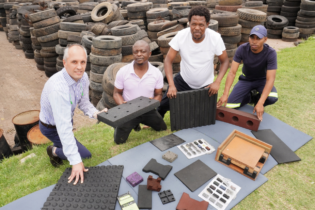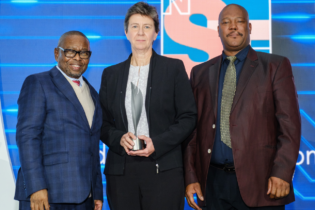The construction of the 1 200 t/d Electron Road Waste Transfer Station by eThekwini Municipality to serve the Durban area is almost 70% complete, Durban Solid Waste (DSW) Marc Wright tells Chantelle Mattheus.
“This new waste management facility is set to provide the region with a modern and mechanised means of transferring municipal general solid wastes to the landfill sites in what has been designed to be as efficient and cost-effective as possible,” says Wright. “Although currently, the process is all about the construction stages as it hasn’t been commissioned yet,” he adds. Wright states that the challenges faced to date have therefore been construction related, adding that these however have been few and far between and easily remedied, such as the use of tilt-up panel wall system. Instead of conventional brickwork laid layer by layer, the system is erected fully formed on-site having been precast in proprietary moulds. “However, it will still have the same facebrick finish,” he explains. Construction on this R140 million-project started on 12March and is set to continue for 78 weeks. “Currently, the project is approximately 70% complete with commissioning projected to take place in September this year,” says Wright. Distinct design Jeffares & Green, the firm of engineering and environmental consultants responsible for designing the facility, was appointed to design a modern and mechanised waste transfer station (WTS) at Electron Road in Springfield Park, an industrial and commercial area north of Durban. The main structure, a refuse transfer station and compaction hall will be built on a site roughly 4 ha in size where waste will be offloaded, compacted and containerised for bulk transportation. The Electron Road WTS will comprise a main four-storey building and some 4 290 m² in plan, in which waste will be offloaded into compaction units, compacted into purpose-made containers for bulk transportation and then transported to the new Buffelsdraai landfill site. As Wright explains, the aim of constructing the facility in the location it is being built in is to somewhat reduce the transport expenses of transferring solid waste to landfills, which are increasingly sited further and further from the point of generation. At present, most of the waste in Durban City is disposed of at the Bisasar Road landfill site in Springfield Park, but this site is reaching capacity. When this is reached, waste collection vehicles will have to travel to the Buffelsdraai landfill site approximately 33 km away – more than double the 15 km distance that is considered an economic travelling cost for collection vehicles. These prohibitive transport costs have made the provision of a WTS financially prudent, particularly since the Electron Road site is less than 1 km from the Bisasar Road site. The reduced transportation will also reduce fuel consumption as well as wear and tear on road systems, with an overall reduction of carbon emissions. Upgrading of Electron Road will provide dedicated access to the site, access roads to the various handling areas within the site, a security building, weighbridge kiosks for the monitoring and recording of waste mass, wash bays for the waste fleet, a car park and covered waiting area at the entrance to the facility. The contract involves the construction of the structures, civil works and infrastructure, and building-related mechanical, electrical, electronic works, together with the mechanical plant for the operation of the facility. The works comprise (but is not limited to): the refuse transfer station, a compaction hall, container-handling operations, offices, weighbridge infrastructure, mechanical equipment and plant. It also contains a workshop, wash bay, diesel storage, security facilities, entrance building and weighbridges.Unique technology
Additionally, the design includes the maximisation of use of natural lighting and ventilation, stormwater treatment, pollution control by means of litter traps, silt traps and oil traps. Specific stormwater treatment processes were designed to control pollution and allow discharge of an acceptable effluent from the site. One item in the stormwater treatment portfolio that has been carefully designed is the bioswale, which is a carefully landscaped and shaped open stormwater system (channel) to enhance the removal of solids, metals and the like. Another element is the stormwater inlets designed to effectively remove litter and sediment before these reach other systems. A unique waste management feature – highlighted by both Jeffares&Green and Wright – is the compaction process that will be used for the first time in South Africa. The system – the Husmann compaction system–was accepted as an alternative design proposed by the successful bidder, Avenge Construction. Imported from Germany, the system is patented to use side rams, explains Wright. In this case, dual side rams are utilised to compact the waste and then move it into the hopper, therefore eliminating the sometimes “messy” use of conveyors. “This process is a lot cleaner, quicker, simpler and hopefully more effective and is definitely new and innovative in the landfill and waste management industry,” says Wright. Sustainable approach Mariannhill Landfill Conservancy Site, just outside Durban, is considered a best-practice ecosystem restoration project and DSW will apply the same award-winning environmental approach at Electron Road. The successful process is driven by PRUNIT (Plant Rescue and Relocation Unit), headed up by Richard Winn, a horticulturalist and rehabilitation specialist. This unit applied the philosophy of moving plant species once only and uses a rehabilitation nursery as a backup when direct relocation is not possible. The basic principles are:- try and relocate species to their original aspect
- import no foreign soils
- relocate grasslands with original topsoil
- relocate original watercourse species to wetland nurseries for future utilisation
- create a similar habitat to what originally occurred
- only relocate species within 50 km as per international biodiversity protocol, preferably closer.







